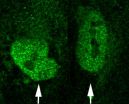(Press-News.org) Irvine, Calif., Jan. 22, 2013 — UC Irvine-led studies have revealed the cellular mechanism by which circadian rhythms – also known as the body clock – modify energy metabolism and also have identified novel compounds that control this action. The findings point to potential treatments for disorders triggered by circadian rhythm dysfunction, ranging from insomnia and obesity to diabetes and cancer.
UC Irvine's Paolo Sassone-Corsi, one of the world's leading researchers on the genetics of circadian rhythms, led the studies and worked with international groups of scientists. Their results are detailed in two companion pieces appearing this week in the early online edition of the Proceedings of the National Academy of Sciences.
"Circadian rhythms of 24 hours govern fundamental physiological functions in almost all organisms," said Sassone-Corsi, the Donald Bren Professor of Biological Chemistry. "The circadian clocks are intrinsic time-tracking systems in our bodies that anticipate environmental changes and adapt themselves to the appropriate time of day. Disruption of these rhythms can profoundly influence human health."
He added that up to 15 percent of people's genes are regulated by the day-night pattern of circadian rhythms.
In one study, Sassone-Corsi and colleagues found that the biological clock controls enzymes localized in the mitochondrion, a cellular structure devoted to energy metabolism. This government occurs through acetylation of proteins, a process that operates as a switch to turn genes on and off in cells based upon the cells' energy usage.
Some of the most important acetylation events in cells are dictated by an enzyme protein called SIRT1, which senses energy levels in the cell. Its activity is modulated by how many nutrients a cell is consuming. It also helps cells resist oxidative and radiation-induced stress. SIRT1 has been linked to the inflammatory response, diabetes and aging.
Sassone-Corsi first showed the circadian rhythm-metabolism link in 2008 and 2009, and in this study, he and his colleagues reveal the metabolic pathways through which SIRT1 works.
"When the balance between clock proteins is upset, normal cellular function can be disrupted," said Sassone-Corsi, who also directs the Center for Epigenetics & Metabolism at UC Irvine.
In exploring how to regulate SIRT1 activity, Sassone-Corsi teamed with scientists from two research-and-development groups at GlaxoSmithKline – one in the United Kingdom and the other (called Sirtris) in the U.S. – to test proprietary small-molecule compounds that stimulate SIRT1.
In mouse studies, they were able to modulate the scale of circadian-driven gene function with the SIRT1-activating compounds, effectively governing the circadian cycle in a host of genes involved with the metabolic rate in cells. This research proves that small molecules can be used as a pharmacological strategy to control circadian disturbances and is a step toward the development of drugs that could target many conditions, including metabolic disorders, diabetes, cancer and aging.
Postdoctoral researchers Selma Masri and Kristin Eckel-Mahan, graduate student Vishal Patel and Chancellor's Professor Pierre Baldi of UC Irvine, along with Shahaf Peleg, Ignasi Forne, Andreas Ladurner and Axel Imhof of Germany's University of Munich, as well as Sassone-Corsi, contributed to the study titled "The Circadian acetylome reveals regulation of mitochondrial metabolic pathways." The National Institutes of Health, the National Science Foundation, INSERM and Sirtris provided support.
In addition to Sassone-Corsi, postdoctoral researcher Marina Bellet and laboratory assistant Marlene Cervantes of UC Irvine; Mohamed Boudjelal, Emma Watts, Danuta Mossakowska and Kenneth Edwards of GlaxoSmithKline; Giuseppe Astarita of Georgetown University; and Christine Loh, James Ellis and George Vlasuk of Sirtris contributed to the study titled "Pharmacological modulation of circadian rhythms by high-affinity SIRT1 activators." The National Institutes of Health and INSERM provided support.
###
About the University of California, Irvine: Founded in 1965, UC Irvine is a top-ranked university dedicated to research, scholarship and community service. Led by Chancellor Michael Drake since 2005, UC Irvine is among the most dynamic campuses in the University of California system, with more than 28,000 undergraduate and graduate students, 1,100 faculty and 9,400 staff. Orange County's second-largest employer, UC Irvine contributes an annual economic impact of $4.3 billion. For more UC Irvine news, visit news.uci.edu.
News Radio: UC Irvine maintains on campus an ISDN line for conducting interviews with its faculty and experts. Use of this line is available for a fee to radio news programs/stations that wish to interview UC Irvine faculty and experts. Use of the ISDN line is subject to availability and approval by the university.
UCI maintains an online directory of faculty available as experts to the media. To access, visit www.today.uci.edu/experts.
END
COLUMBUS, Ohio – A new study could provide the link that scientists have been looking for to confirm that reactivation of a latent herpes virus is a cause of some heart problems.
Looking at blood samples from 299 heart patients, researchers at Ohio State University found that those who had suffered a heart attack were the most likely to have inflammatory proteins circulating in their blood compared to patients with less acute symptoms. And having more of one of these proteins in the blood was linked to the presence of antibodies that signal a latent Epstein-Barr virus ...
Muscular dystrophy is caused by the largest human gene, a complex chemical leviathan that has confounded scientists for decades. Research conducted at the University of Missouri and described this month in the Proceedings of the National Academy of Sciences has identified significant sections of the gene that could provide hope to young patients and families.
MU scientists Dongsheng Duan, PhD, and Yi Lai, PhD, identified a sequence in the dystrophin gene that is essential for helping muscle tissues function, a breakthrough discovery that could lead to treatments for the ...
NASA's Aqua satellite documented the formation of Tropical Storm Oswald in the Gulf of Carpentaria on Jan. 21 and the landfall on Jan. 22 in the southwestern Cape York Peninsula of Queenstown, Australia. Oswald has since become remnant low pressure area over land.
Tropical Storm Oswald was hugging the southwestern coast of the Cape York Peninsula, Queensland, Australia when NASA's Aqua satellite first flew overhead on Jan. 21 at 0430 UTC (Jan. 20 at 11:30 p.m. EST). The Moderate Resolution Imaging Spectroradiometer (MODIS) instrument aboard NASA's Aqua satellite captured ...
Jan. 22, 2013 - A common type of bacteria may help pigs stay healthy during weaning.
In a study of 36 weanling-age pigs, researchers found that a dose of lipid-producing Rhodococcus opacus bacteria increased circulating triglycerides. Triglycerides are a crucial source of energy for the immune system.
"We could potentially strengthen the immune system by providing this bacterium to animals at a stage when they are in need of additional energy," said Janet Donaldson, assistant professor in Biological Sciences Mississippi State University. "By providing an alternative ...
A novel software tool, developed at The Children's Hospital of Philadelphia, streamlines the detection of disease-causing genetic changes through more sensitive detection methods and by automatically correcting for variations that reduce the accuracy of results in conventional software. The software, called ParseCNV, is freely available to the scientific-academic community, and significantly advances the identification of gene variants associated with genetic diseases.
"The algorithm we developed detects copy number variation associations with a higher level of accuracy ...
This flu season you've probably seen a number of friends on social media talking about symptoms.
New research from Brigham Young University says such posts on Twitter could actually be helpful to health officials looking for a head start on outbreaks.
The study sampled 24 million tweets from 10 million unique users. They determined that accurate location information is available for about 15 percent of tweets (gathered from user profiles and tweets that contain GPS data). That's likely a critical mass for an early-warning system that could monitor terms like "fever," ...
NEW BRUNSWICK, N.J. – Coming out to one's family can be stressful, but gay black males face a unique set of personal, familial and social challenges.
"Parents and youths alike worry that gay men cannot meet the rigid expectations of exaggerated masculinity maintained by their families and communities," says Michael C. LaSala, director of the Master of Social Work program at Rutgers University School of Social Work. LaSala, an associate professor, recently completed an exploratory study of African American gay youth and their families from urban neighborhoods in New York ...
BUFFALO, N.Y. – New University at Buffalo research demonstrates how defects in an important neurological pathway in early development may be responsible for the onset of schizophrenia later in life.
The UB findings, published in Schizophrenia Research (paper at http://bit.ly/Wq1i41), test the hypothesis in a new mouse model of schizophrenia that demonstrates how gestational brain changes cause behavioral problems later in life – just like the human disease.
Partial funding for the research came from New York Stem Cell Science (NYSTEM).
The genomic pathway, called the ...
NEW YORK (January 22, 2013) -- A research study of more than 600 black patients with uncontrolled hypertension found that less than half were prescribed a diuretic drug with proven benefit that costs just pennies a day, report researchers at Weill Cornell Medical College and the Visiting Nurse Service of New York's (VNSNY) Center for Home Care Policy and Research. The researchers say these new findings should be taken as a serious wake-up call for physicians who treat black patients with hypertension.
Their study, reported in the American Journal of Hypertension, found ...
ALEXANDRIA, Va. – New research into the treatment and prognosis of gastrointestinal cancers was released today in advance of the tenth annual Gastrointestinal Cancers Symposium being held January 24-26, 2013, at The Moscone West Building in San Francisco, CA.
Five important studies were highlighted today in a live presscast:
Postoperative Treatment with S-1 Chemotherapy Reduces Relapses and Extends Survival in Patients with Pancreatic Cancer: Early results from a Phase III clinical trial conducted in Japan show patients who received the chemotherapy drug S-1 after ...

